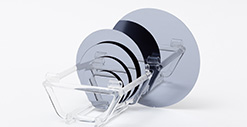Silicon single crystal wafer containing dopants with a thickness of less than 1μm.
About CCMC
Company Profile 

President Speech 

Corporate Concept 

Service Location 

Development History 

Customer Commitment 

Team Building 

About CCMC
CCMC is committed to becoming one of the main suppliers of semiconductor silicon wafers in the world, breaking the long-term foreign monopoly on the domestic semiconductor silicon wafer market, and realizing the true "Chinese smart manufacturing" in the semiconductor silicon material industry.

Products and Technology
About semiconductor silicon wafers 

List of Semiconductor Products

Manufacturing Methods of Semiconductor Wafers 

Manufacturing Capabilities and Technical Advantages 

Q&A about Silicon 

Download Center 

Products and Technology
The semiconductor silicon wafers of CCMC have various specifications, different material characteristics and surface treatment methods.

News Center
News Center
From now on, describe the wonderful moments of CCMC. Every moment will become a historical milestone.
Human Resources
Human Resources
Contact Us
Contact Us



